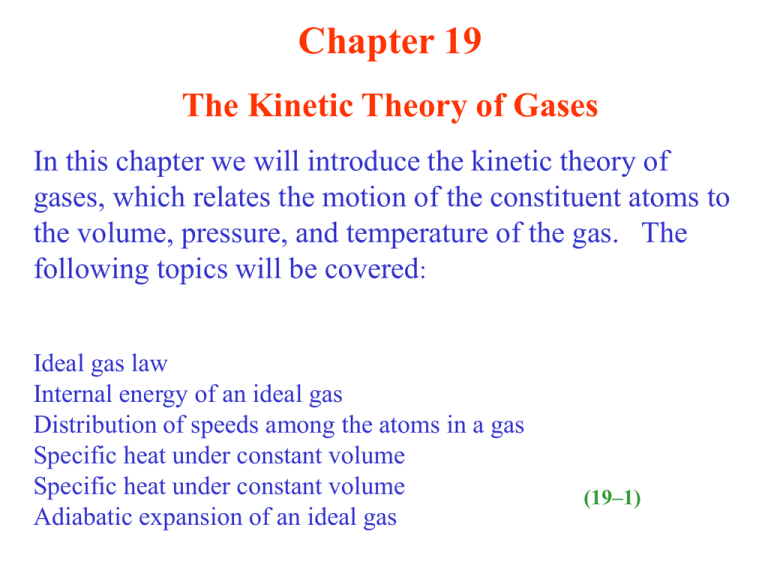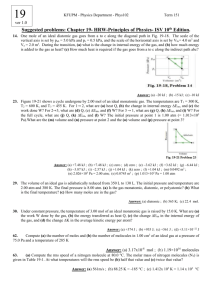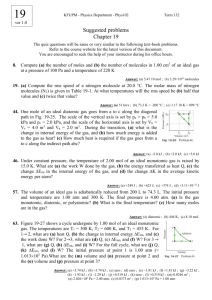Kinetic Theory of Gases: Ideal Gas Law & Thermodynamics
advertisement

Chapter 19 The Kinetic Theory of Gases In this chapter we will introduce the kinetic theory of gases, which relates the motion of the constituent atoms to the volume, pressure, and temperature of the gas. The following topics will be covered: Ideal gas law Internal energy of an ideal gas Distribution of speeds among the atoms in a gas Specific heat under constant volume Specific heat under constant volume Adiabatic expansion of an ideal gas (19–1) n M sam M sam N M mN A N A Avogadro's Number A "mole" of any substance is defined as the quantity contained in a mass equal to the molar mass of the substance. The mole of any substance contains the same number of atoms (or molecules). This is known as "Avogadro's number ": N A 6.02 1023 atoms/mole. The number n of moles in a sample of mass M sam of a substance is given by the ratio M sam N n . Here M is the molar mass of the substance. The number n . M NA Here N is the number of atoms in the mass M sam . The mass M sam mN A . Here m is the mass of each molecule. (19–2) pV nRT pV NkT Ideal Gases, Ideal Gas Law It was found experimentally that if 1 mole of any gas is placed in containers that have the same volume V and are kept at the same temperature T , approximately all have the same pressure p. The small differences in pressure disappear if lower gas densities are used. Further experiments showed that all low-density gases obey the equation pV nRT . Here R 8.31 K/mol K and is known as the "gas constant." The equation itself is known as the "ideal gas law." The constant R can be expressed as R kN A . Here k is called the Boltzmann constant and is equal to 1.38 10-23 J/K. If we substitute R as well as n N in the ideal gas law we get the equivalent form: NA pV NkT . Here N is the number of molecules in the gas. The behavior of all real gases approaches that of an ideal gas at low enough densities. Low densities means that the gas molecules are far enough apart that they do not interact with one another, but only with the walls of the gas container. (19–3) Example 1: Work Done by an Ideal Gas at Constant Temperature Consider the gas shown in the figure. It is held at a constant temperature T and undergoes an isothermal expansion from volume Vi to volume V f . The process follows the red line on the lower figure. The work W done by the ideal gas is given by the equation Vf W pdV . From the ideal gas law we have that Vi Vf Vf nRT nRT dV V p W dV nRT nRT ln V V f ; i V V V Vi Vi W nRT ln Vf Vi . For expansion we have : V f Vi ln Vf Vi For compression we have : V f Vi ln 0 W 0. Vf 0 W 0. Vi (19–4) Example 2: Example 3: Example 4: Work Done by an Ideal Gas at Constant Volume p Consider process a f . During this process the volume of the ideal gas is kept constant. Thus the work W done by the gas is Vi Vf W pdV 0. Work Done by an Ideal Gas at Constant Pressure Consider process i a. During this process the pressure is kept constant at p and the volume changes from Vi to V f . The work W done by Vf the gas is W Vf pdV p dV p V Vi f Vi . Vi (19–5) Example 5: Example 6: Ideal Gas Pressure, Temperature, and RMS Speed Consider the molecule of mass m moving inside a container of dimensions L L L as shown in the figure. We will follow the motion of the molecule along the x-axis. The molecule bounces off the walls 2L with time interval t between collisions. vx px mvx mvx 2mvx mvx 2 The ratio Fx . Here px is the momentum t t 2 L / vx L transfer to the wall. The force exerted by one molecule Fx px . Thus the pressure t p exerted by all the molecules on the wall is given by 2 Fx mvx21 / L mvx22 / L ... mvxN /L m 2 2 2 p 2 v v ... v xN . 3 x1 x 2 L L2 L The root mean square (RMS) value for vx is defined as v 2 x avg v 2 x1 2 vx22 ... vxN N 2 vx21 vx22 ... vxN N vx2 avg . (19–6) 2 nMvrms p 3V vrms 3RT M Nm 2 v . 3 x avg L For each molecule the speed v 2 vx2 v y2 vz2 . Thus the gas pressure p The average values of the squares for each v2 component are equal. Thus: v . 3 2 x 2 nMvrms Thus p . This equation tells us how the gas pressure depends on the speed 3V of the gas molecules. If we solve this equation for vrms we get vrms vrms 3Vp , nM 3nRT 3RT . nM M (19–7) Example 7: The molar mass of argon is 39.95 g/mol. vrms 3 8.31J/mol K 313K 3RT 442 m/s. 3 M 39.95 10 kg/mol Example 8: K avg Translational Kinetic Energy mv 2 The kinetic energy of a gas molecule K . 2 2 mv 2 mvrms Its average kinetic energy K avg . 2 2 avg Thus K avg 3kT 2 m 3RT 3RT . 2 M 2NA We finally get: K avg 3kT 2 At a given temperature T all ideal gas molecules, no matter what their mass, have the same average translational kinetic energy. When we measure the temperature of a gas, we are also measuring the average translational kinetic energy of its molecules. (19–8) Example 9: K avg 3 (1.38 1023 J/K) (1600 K) = 3.31 1020 J . 2 3nRT Eint 2 Internal Energy of an Ideal Gas Consider a monatomic gas such as He, Ar, or Kr. In this case the internal energy Eint of the gas is the sum of the translational kinetic energies of the constituent atoms. The average translational kinetic energy of a single atom is given by the equation K avg 3kT . 2 A gas sample of n moles contains N nN A atoms. The internal energy of the gas Eint NK avg nN A 3kT 3nRT . 2 2 The equation above expresses the following important result: The internal energy Eint of an ideal gas is a function of gas temperature only; it does not depend on any other parameter. (19–11) CV 3R 2 Eint nCV T Molar Specific Heat CV at Constant Volume Consider n moles of an ideal gas at pressure p and temperature T . The gas volume is fixed at V . These parameters define the initial state of the gas. A small heat quantity Q is added from the reservoir that changes the temperature to T T and the pressure to p p and brings the system to its final state. The heat Q nCV T . The constant CV is called the molar specific heat at constant volume. From the first law of thermodynamics we have: Q Eint W and W pV 0. Eint Thus Q Eint nCV T CV = . nT 3nRT 3nRT 3R Eint Eint CV 2 2 2 We can write the internal energy of the gas in the following form: Eint nCV T (19–12) E nC T . int V C p CV R Molar Specific Heat C p at Constant Pressure We assume that we add a heat amount Q to the gas and change its temperature from T to T T and its volume from V to V V while keeping the pressure constant at p. The heat Q nC p T . The constant C p is called molar specific heat at constant pressure. The first law of thermodynamics gives: Q W Eint nC p T pV nCV T . Using the law of ideal gases pV nRT we get: pV nRT nC p T nRT nC p T . Thus: C p CV R. (19–13) Checkpoint 4: The figure here shows five paths traversed by a gas on a p-V diagram. Rank the paths according to the change in internal energy of the gas, Greatest First. Example 10: pV i i p f Vf TV i i 1 Tf V f Adiabatic Expansion of an Ideal Gas 1 Consider the ideal gas in fig. a. The container is well insulated. When the gas expands, no heat is transferred to or from the gas. This process is called adiabatic. Such a process is indicated on the p - V diagram of fig. b by the red line. The gas starts at an initial pressure pi and initial volume Vi . The corresponding final parameters are p f and V f . The process is described by the equation piVi p f V f . Here the constant Cp CV . Using the ideal gas law we can get the equation TV i i 1 Tf V f 1 Vi 1 T f Ti 1 Vf If V f Vi we have adiabatic expansion and T f Ti . If V f Vi we have adiabatic compression and T f Ti . (19–15) Ti T f piVi p f V f Free Expansion In a free expansion, a gas of initial volume Vi and initial pressure pi is allowed to expand in an empty container so that the final volume is V f and the final pressure p f . In a free expansion Q 0 because the gas container is insulated. Furthermore, since the expansion takes place in vacuum the net work W 0. The first law of thermodynamics predicts that Eint 0. Since the gas is assumed to be ideal there is no change in temperature: Ti T f . Using the law of ideal gases we get the following equation, which connects the initial with the final state of the gas: piVi p f V f . (19–16) Checkpoint 5: Rank paths 1,2 and 3 in Fig according to the energy transfer to the gas as heat Greatest First. Example 11: Example 18: Example 19: Example 20: Example 21: Example 22: Example 23: Example 24: Example 25: Example 26: Example 27: Example 28: Example 29: Example 30: Example 31: Example 32: Example 33: Example 34: Example 35: Example 36: Example 37: Example 38:










